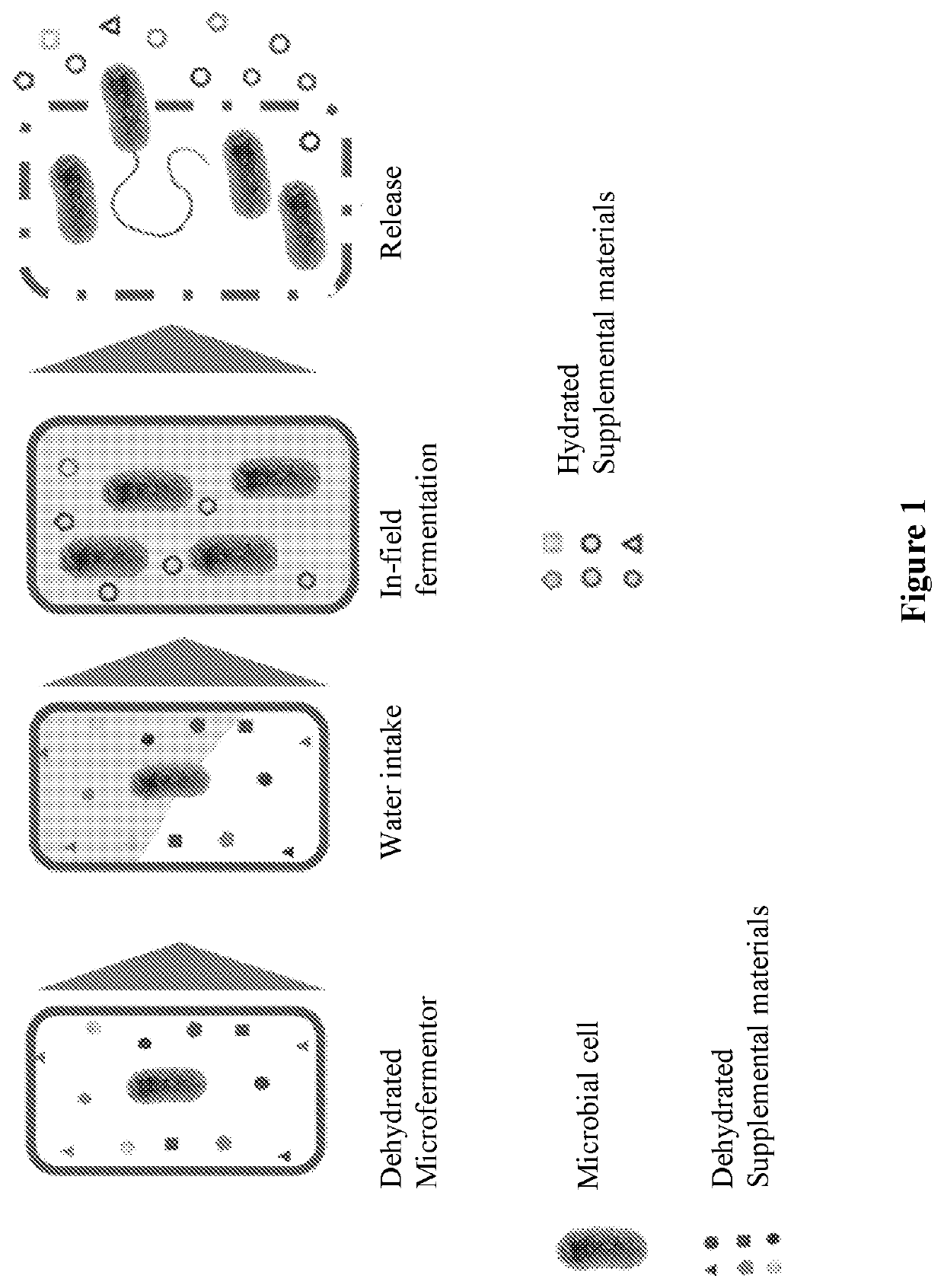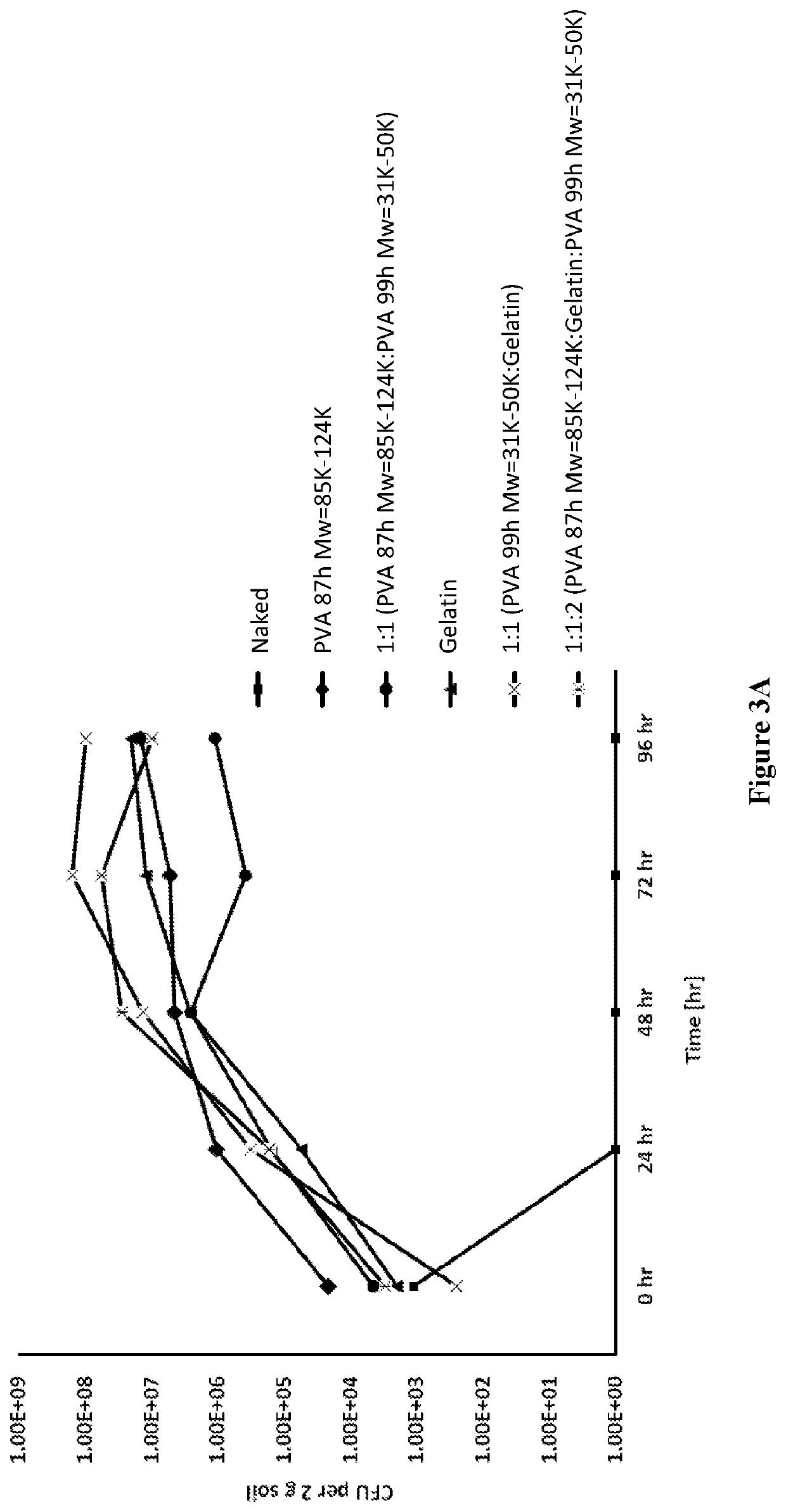Encapsulated microorganisms and methods of using same
a technology of microorganisms and encapsulated cells, applied in the field of encapsulated microorganisms and methods of using same, can solve the problems of not enabling the release of encapsulated microorganisms, and achieve the effects of increasing crop productivity, enhancing survival chances, and increasing crop productivity
- Summary
- Abstract
- Description
- Claims
- Application Information
AI Technical Summary
Benefits of technology
Problems solved by technology
Method used
Image
Examples
example 1
ion of Bacterial Strains Prior to Encapsulation
[0089]One strain (Pseudomonas chlororaphis, Phylum Proteobacteria) was tested for microfermentation in soil. It is to be understood that other strains e.g. Arthrobacter globiformis (Phylum Actinobacteria) and Bacillus endophyticus (Phylum Firmicutes) can also be used. Strains are removed from cryogenic or lyophilized storage. Inocula are prepared by either direct transfer to a suitable liquid media (LB, NB, TSB, R2A or other bacteriological growth medium) and incubation in a shaker incubator for 10-15 hours at 200 rpm and 28° C., or transfer to an agar plate media (LB, NB, TSB, R2A or other bacteriological growth medium) and growth for 24-48 hours before selecting colonies for transfer to a suitable liquid media. The inocula are transferred to a shake flask or a fermenter. Fermenter includes standard pH and dissolved oxygen (DO) probes; temperature and pH control; and programmed nutrient feeding. Media containing a suitable carbon sourc...
example 2
on with Chemical Additives without Encapsulation
[0091]Three methods are employable as follows:
Method 1: Bacteria are harvested by centrifugation at 10,000 g and 4° C. for 10 min. The pellet is mixed with 20% Microcel-E or Sipernat 22S, 10% mannitol, maltodextrin, sorbitol, and / or skim milk powder using a coffee grinder. The wet powder is dried in a force air oven at 40° C.
Method 2: Bacteria are harvested and re-suspended in water to a tenth of the initial (fermentation) volume. The bacterial suspension is mixed with 5% mannitol, maltodextrin, sorbitol, and / or skim milk powder and is sprayed onto Microcel-E or Sipernat 22S using a Strea-1 fluid bed dryer. Inlet temperature is kept at 40° C.
Method 3: Bacteria are harvested and re-suspended in water to a tenth of the initial (fermentation) volume. The bacterial suspension is mixed with 5% mannitol, maltodextrin, sorbitol, skim milk powder, and / or gum arabic or 3% skim milk powder and 2% gum arabic and is dried with a Buchi B-290 spray ...
example 3
tion
[0092]Generation of electrospun capsules is conducted in a manner known in the art, such as in Damasceno et al. (Can. J. Microbiol. 59, 716-719 (2013)). Bacteria are harvested by centrifugation at 10,000 g and 4° C. for 10 min and the paste is re-suspended in sterile 0.9% NaCl, containing glucose, sucrose, molasses, cellulose or starch, at a concentration of up to 100 μg / liter, and an extract or digest of casein, soy, corn and / or yeast at a concentration of 20-200 μg / liter. A sterilized solution of 30% PVA in distilled water is added to the suspended cells to a final concentration of 15% PVA. To polymerize the capsules around the microbial cells, the solution is transferred to 5 ml syringes, and extruded at a syringe descent rate of 0.01 mm / s through a needle at a voltage of 22 kV and into a collection tube at a distance of 14 cm, in a manner calculated to create capsules of 50 μm diameter, with a permeability of 0.5 kDa molecular weight cut-off (MWCO). The capsul...
PUM
| Property | Measurement | Unit |
|---|---|---|
| diameter | aaaaa | aaaaa |
| diameter | aaaaa | aaaaa |
| diameter | aaaaa | aaaaa |
Abstract
Description
Claims
Application Information
 Login to View More
Login to View More - R&D
- Intellectual Property
- Life Sciences
- Materials
- Tech Scout
- Unparalleled Data Quality
- Higher Quality Content
- 60% Fewer Hallucinations
Browse by: Latest US Patents, China's latest patents, Technical Efficacy Thesaurus, Application Domain, Technology Topic, Popular Technical Reports.
© 2025 PatSnap. All rights reserved.Legal|Privacy policy|Modern Slavery Act Transparency Statement|Sitemap|About US| Contact US: help@patsnap.com



